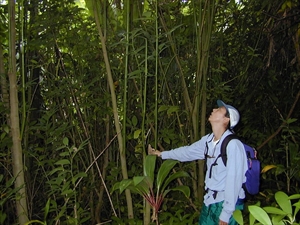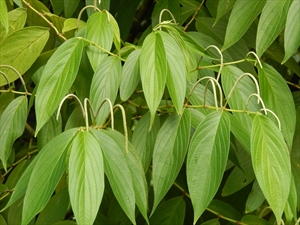Spiked pepper. It is also known as bamboo piper, yaqona ni (Fiji), and false kava (note, this is also the name given to Piper auritum (see Fact Sheet no. 492).
Pacific Pests, Pathogens, Weeds & Pesticides - Online edition
Pacific Pests, Pathogens, Weeds & Pesticides
Spiked pepper (493)
Piper aduncum. It is a member of the Piperaceae.
Southeast Asia, Africa (Tanzania), North (Florida, Hawaii), South and Central America, the Caribbean, Oceania. It is recorded from American Samoa, Cook Islands, Federated States of Micronesia, Fiji, Niue, Northern Mariana Islands, Papua New Guinea, Samoa, Solomon Islands, Tonga, and Vanuatu. It is native to the Caribbean and tropical America.
An invasive shrub, aggressively colonising disturbed habitats in secondary forests, roadsides, waterways, and cultivated lands, e.g., plantations and pastures, and fallows (Photo 1). Its invasiveness is due to characteristics of pioneer species: production of large quantities of seed, rapid growth rate and, in this case, an ability to regenerate vegetatively. It is tolerant of a wide range of rainfall zones (rainforest to savanna), and grows from sea level to 2000 masl. It is a difficult weed to control.
A shrub or small tree growing up to 8 m (Photo 2). Stems, single or multiple, swollen at the nodes, and often supported by stilt roots. Leaves, alternatively along branches; leaf blades roughly oval, 12-22 cm long and 4-8 cm wide, tapering to a point, with short leaf stalks, and soft hairs on lower surfaces (photo 3). Leaves give an aromatic smell when crushed. Flower spikes, with embedded flowers, each producing a single seed, about 1 mm long, becoming black when ripe (Photo 4).
The seeds are dispersed by birds (in Fiji, the red-vented bulbil), bats and wind, as well as on clothing, vehicles and logging equipment. There are documented cases of introductions associated with packing materials, and also movement of plants as ornamentals.
A weed causing environmental and economic impacts. It is increasingly becoming a serious weed of pastures, roadsides and fallows in Papua New Guinea. There and in Irian Jaya, its rapid growth forms dense stands preventing regeneration of slower-growing native timber species and reducing diversity. In Fiji, an aggressive weed from sea level to 400 m in thickets alongside roads and in secondary forests. Consignments of true kava, Piper methysticum, may become contaminated at harvest, lowering its quality and value. It is also a host to pathogens of (true) kava.
Used as an ornamental. In Papua New Guinea, considered useful in improving soil fertility, preventing soil erosion, providing habitats for wild animals, shade and wind breaks. It is also used as stakes for fences and as a fuel. Oil extracted from the plant is used to control mosquitoes.
BIOSECURITY
The chances of introduction of spiked pepper is high, most likely accidentally. Countries not yet infested by with this shrub should consider all likely pathways for entry, and apply quarantine measures accordingly. Particular attention should be given to its spread as seed and in consignments of true kava.
Piper aduncum is on the Global Invasive Species Database (2021) of information on alien and invasive species that negatively impact biodiversity, managed by the Invasive Species Specialist Group of the IUCN Species Survival Commission: (http://www.iucngisd.org/gisd/speciesname/piper+aduncum).
BIOLOGICAL CONTROL
Not a method recommended for spiked pepper.
CULTURAL CONTROL
- Physical & Mechanical:
- Hand-pulling is possible, but can make the situation worse if roots remain as they will sprout to grow new plants.
- Slash and burn thickets. Cuttings should not be left on site as they will regrow. They should be collected and burned.
- Hygiene:
- Treat vehicles and farm machinery. If moving from areas where the weed occurs to those weed-free, wash to remove soil. This is equally important if the machinery is being imported into a country or moved within a country.
CHEMICAL CONTROL
Use a systemic herbicide, such as triclopyr, applied to the basal bark or cut stems, about 15 cm above ground level, and spray immediately with herbicide.
____________________
When using a pesticide, always wear protective clothing and follow the instructions on the product label, such as dosage, timing of application, and pre-harvest interval. Recommendations will vary with the crop and system of cultivation. Expert advice on the most appropriate herbicides to use should always be sought from local agricultural authorities.
AUTHOR Grahame Jackson
Information from CABI (2019) Piper aduncum. Invasive Species Compendium. (https://www.cabi.org/isc/datasheet/41354); and Piper aduncum L. (2020) Weeds Australia - Profiles. Centre for Invasive Solutions, Department of Agriculture, Water and the Environment. Australian Government. (https://profiles.ala.org.au/opus/weeds-australia/profile/Piper%20aduncum); and from Piper aduncum L., Piperaceae (2011) Pacific Islands Ecosystems at Risk (PIER). (http://www.hear.org/pier/species/piper_aduncum.htm). Photos 1-4 Forest & Kim Starr. Piper aduncum (Spiked pepper).
Produced with support from the Australian Centre for International Agricultural Research under project HORT/2016/185: Responding to emerging pest and disease threats to horticulture in the Pacific islands, implemented by the University of Queensland and the Secretariat of the Pacific Community.







